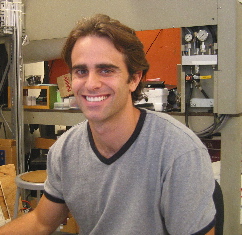new web: http://bdml.stanford.edu/pmwiki
TWiki > Rise Web>TWikiUsers>MattSpenko (20 Aug 2007, MarkCutkosky)
Rise Web>TWikiUsers>MattSpenko (20 Aug 2007, MarkCutkosky)
|

|
TreeClimbingProgress
TreeRobotDesign
GroupPresentation List
QuadraRiSE
Testing 2/27-2/28 2006
- Use DIVX player to watch. Tried with quicktime on PC and had issues.
- Used Sutcco FF gait for all tests.
- Sangbae's latest toes uses smaller spines - climbed sheetrock at 81 deg at v = 0.15. Failed at 90 deg.
- RiSESheetrocksbToes66-80DIVX.mov:
- Bigtoes with lamellar pads - failed sheetrock at 81 deg. Lower angles not tested.
- RiSESheetrockBigToes90DIVX.mov:
- RiSESheetrockBigToes81.mov:
- Bigtoes with lamellar pads on plexiglass - maintains position at 56 deg - cannot climb 56 deg. Climbs at 44 deg.
- RiSEPlexiBigToes56DIVX.mov:
- RiSEPlexiBigToes45DIVX.mov:
- Bigtoes with lamellar pads on stucco to plexiglass transistion - Lamellar pads get to dirty and fails.
- RiSEStuccoPlexiBigToes.mov:
- Bigtoes with lamellar pads on plexiglass 45 deg after climbing on stucco - fails due to dirtiness of pads
- RiSEPlexiAfterStucco.mov:
- Sangbae's toes with sorbothane pads on 45 deg - climbs. On plexiglass to stucco transition - fails transition. The spines could not engage due to height of sorbothane pads. Should be an easy fix. On plexiglass after climbing on stucco - OK, but noticible performance loss. See picture
- RiSEPlexiStuccosbToesDIVX.mov:
- Actuated foot - Not bad, but there was some decrease in performance. Needs discussion. Did not climb using dactyls only spinyfoot
- RiSEStuccoActFoot.mov:
Rise Spacer Design
Current Work
StabilityMargin?
- Work using adhesion in a stability margin calculation to make the stability margin applicable to climbing robots.
MicrohairIntegration?
- Learn about my most recent efforts to integrate microhairs with a suspension system.
GaitDevelopment from CMU
New Toe Fabrication and Design
- I am curently designing and building new toes. See RiSESpinyFeetSept08. This was the first set of toes that I designed and manufactured. Some of the issues with the design had to deal with the use of 35A polymer. We have found the polymer to have inconsistent cure properties and we have difficulties removing the excess polymer after the toes had cured. In response, Alan and I have decided to pursue toe designs that only use 90A polymer. This will allow us to plane the material (with the Haas) after it has cured and will hopefully have more consistent curing properties.
Microhair integration with SDM process
- After a recent visit to Berkeley, SangbaeKim and I are working on the integration of their microhairs with our SDM process. See MicrohairIntegration for more details.
Microsuspension
- I am trying to develop a microsuspension for small individual spines. At this point I have lots of dead end designs. As soon as something works, I'll post it. A couple new ideas.
Interesting Research Topics That Don't Have a High Priority
- What control algorithm is best for controlling the internal force distribution of the robot? i.e. force control, impedance control?
- Is there a gripping mechanism that will allow for greater adhesion to the wall?
- What kind of mechanical compliance is needed on the foot?
- Can we design an ankle whose compliance we can actively change?
- Given a trajectory, control the robot body on that trajectory for a given velocity. Inputs to the system are 12 joint angles, surface properties. Do not give it a specific gait.
- Can the trajectory space be applied to the robot, or is there really even a need for a trajectory space representation since the robot is moving so slowly. Could be an interesting approach for dynamic climbing.
- Sorbothaneafterclimbingstucco.JPG:
Ideas, requests, problems regarding TWiki? Send feedback